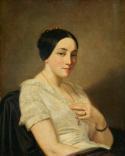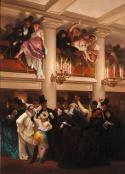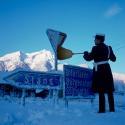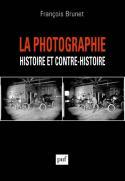Art Of The Day Weekly
#490 - from 9 November 2017 to 15 November 2017
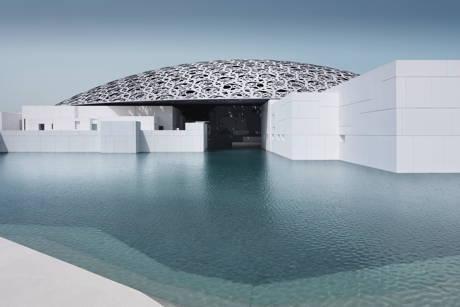
Louvre Abu Dhabi, exterior. Photography: Mohamed Somji.
IN THE AIR
D-day for the Louvre Abu Dhabi
600 / 300 / 13 / 10. These few figures define the Louvre Abu Dhabi. It is to open on 11 November following a delicate, ten-year long conception, following the agreement signed in 2007 between France and the Emirate. But it has at least reached a result, which is not yet the case of the Guggenheim, nor of the National museum, whose buildings have been respectively entrusted to Frank Gehry and Norman Foster. The figures represent the 600 works of art presented, of which 300 are on loan by the Louvre and 300 from 13 partner museums, for a 10-year rotating base. This history of art presented in 12 chapters does not give much space – as we can well imagine - to nudes, to subversive art nor to scandalous works. But it does hold a good number of masterpieces, such as the Belle Ferronnière(Portrait of an Unknown Woman) by Leonardo da Vinci, a Self-portrait by Van Gogh, including Manet’s Fifre, next to a Gothic Bible, a “Blue” Koran, and a Greek Sphinx. It covers a wide range, and one can ask whether it corresponds to the concept of a universal museum, or rather to a luxury showroom. The inauguration itself is set out to be a diplomatic success, meant to represent a unique example of cultural cooperation. It must confirm the post-oil era, a shift of a region that no longer wishes to be seen solely for its petrodollars, its airline hubs, and its hesitant commitment in favor of the rights of women and immigrants. But the success of this adventure will only be confirmed in the medium term, and in particular by the quality of the four annual exhibitions. The first, to open on 21 December, is “From one Louvre to another”. • The website of the Louvre Abu Dhabi (trilingual French-English-Arabic)
• A critical view of the inauguration by the Tribune de l’art
EXHIBITIONS
In the Gurlitt labyrinth
BONN – The discovery, in 2013, of the Gurlitt art collection, seized by the Land of Bavaria, had created a storm in the art world. It had been hidden for decades, after been amassed by an art dealer who was active in Hamburg, Hildebrandt Gurlitt (1895-1956), who had close ties to the Nazis, in spite of having a Jewish mother. His son Cornelius bequeathed it to the Kunstmuseum of Bern, before dying in 2014. The origin of this collection, including works by Matisse, Macke, Boudin, Maillol, and Seurat, is of course the crux. The German State financed the research carried out by the German Lost Art Foundation, which to date has concluded for 573 of the 1566 works: 7 were qualified as being looted art, 278 are without fault, as a certain number of them are even dedicated to Gurlitt, and 231 are the result of raids on museums in order to pull out all “degenerate” art. Gurlitt was even one of the four dealers in charge of selling these works on the international market. The research continues on the remaining 1039 works. At this intermediary stage, the museum in Bern, and the Bundeskunsthalle of Bonn have decided to show a first sample, giving the pedigree of each work. While it is rather easy to determine that View of the Seine by Théodore Rousseau was bought by Gurlitt at an auction at the hôtel Drouot on 11 December 1942, it takes time and the qualities of a sleuth to investigate the origins of Portrait of a young woman , by Thomas Couture and know how and when it left the collection of Georges Mandel – various times a minister, murdered by the Militia in July 1944.
• Gurlitt: Status Report at the Bundeskunsthalle, from 3 November 2017 to 11 March 2018.
• Gurlitt : Status Report at the Kunstmuseum in Bern, from 2 November 2017 to 4 March 2018.
A 19th century now forgotten
ZURICH – What ever happened to Bouguereau, Meissonier, Couture, Cabanel, and others of their like? They were the stars of French academic painting in the 19th century, excellent practitioners surrounded by large workshops, who dedicated their talent to mundane portraits or antique allegories brightened up by charming female figures. They have been forgotten, together with their Births of Venus, Fallen Angels, and other Cincinnatus receiving the ambassadors. Forgotten, in spite of their brilliant reputation. They were after all the glories of the Salon, the mandatory test for all painters, and as such seemed to be protected from such neglect. The exhibition compares them to those who replaced them, Courbet, Manet, Cézanne, and others of the same caliber, and in doing so shows the role they played in modernity. Some of them even produced a type of social painting no one expected from them. What was once declassified as being tacky or old fashioned automatically comes back into fashion, so maybe the time has come to take a new interest in Paul Delaroche, Alfred Stevens or Eugène Giraud.
• Acclamée et brocardée, la peinture française 1820-1880 (Praised and Ridiculed, French painting 1820-1880), at the Kunsthaus Zurich, from 10 November 2017 to 28 January 2018.
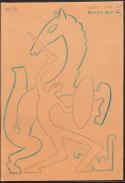
Serguei Eisenstein, from the cycle Idée sur la musique, 1945, black and blue pencil on paper. National Archives for Art and Literature, Moscow.
Eisenstein’s pencil
FLORENCE - Sergei Eisenstein (1898-1948) is known for his movies, among them October, Battleship Potemkin or Que viva Mexico!. He was the son of an Art nouveau architect who left his mark in the city of Riga in particular. But Sergei had various talents. Nourished by the essence of the Russian Revolution, he drew regularly, much influenced by the old masters, be it the Italian Quattrocento, or contemporaries such as Matisse. Seventy drawings on loan from Russia show how this aspect of his work helped him define his ideas for his movies, or to give a graphic form to eternal themes – such as music or death.
• Ejzenštejn: la rivoluzione delle immagini at the Uffizi Museum (Sala di Levante), from 7 November 2017 to 7 January 2018.
FAIRS
The realm of photography
PARIS –Swallows and primroses announce spring, major fairs now rhythm the seasons of the world of art. It may have already been the case in 19th century when all would go religiously to the Salon. In any case, Paris Photo is back. Following the 2015 edition overshadowed by the terrorist attacks, and a year to re-launch it, the fair opens its 21st edition with strong figures to lean on: 190 exhibitors (of which 151 galleries from 29 different countries), over 1000 artists and 60,000 visitors expected, with a new section dedicated to movies and video. It is true that the borders between genres are increasingly blurry. The main guest this year is Karl Lagerfeld, the stainless designer with the divine ponytail and the dark glasses who turned to photography a bit late in life – some 30 years ago- but with great intensity. From the pioneer negative by Louis Adolphe Humbert du Mollard – a garden in 1848, at Hershkowitz – to a beautiful portrait of Lilian Gish in 1923 by Emil Orlik, at Faber, including recent still lives by Olivier Richon, at Bendana-Pinel, or false vintage images by Rob Ball on Coney Island, at Dewi Lewis, the growing ocean of photography makes heads turn, erratically.
• Paris Photo at the Grand Palais, from 9 to 12 November 2017.
OPENINGS OF THE WEEK

RADU COMSA - After the disco
10 November 2017 - PARIS - Galerie Emmanuel Hervé
A Romanian artist (born 1975) plays with concepts and colors
BOOKS
Is photography a distorting mirror, or not?
The book includes fundamental questions, such as whether photography helps to document history objectively or on the contrary is used to build an imaginary world; does it describe reality or does it alter it; is it a show or a tool of knowledge. The questions are illustrated in particular by the American case - the turn of the Civil War, the extraordinary vogue of the stereoscope in the years between 1860-1900, the multitude of archives and their use by historians, the role of photo-clubs and amateurs, etc. These questions are more important today than ever before. While Stalin strived to make photos say what he wished, while the theory of flying saucers could be credited, the same problem has simply being magnified with the new techniques to retouch photos and by the lack of control over the hundreds of sources. This was witnessed with the Arab Spring, as well as with the recent hurricanes or the events in Catalonia, where the prejudice in favor of photography as a medium benefitted a series of false images.
• La photographie, histoire et contre-histoire by François Brunet, PUF, 2017, 400 p., €27.

